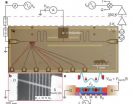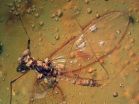(Press-News.org) Ustekinumab, an antibody proven to treat the skin condition psoriasis, has now shown positive results in decreasing the debilitating effects of Crohn's Disease, according to researchers at the University of California San Diego, School of Medicine. The study will appear in the October 18, 2012 issue of the New England Journal of Medicine (NEJM).
Results from the clinical trial showed ustekinumab (Stelara) increased clinical response and remission in patients suffering from moderate-to-severe Crohn's Disease - a form of inflammatory bowel disease (IBD) that can lead to a variety of distressing symptoms, including diarrhea, intestinal bleeding and weight loss. Serious complications such as bowel obstruction and abscesses can also occur.
"Our biggest challenge in treating patients with Crohn's Disease is managing patients whose bodies are resistant to tumor necrosis factor (TNF) inhibitors such as Remicade, Humira and Cimzia," said Sanborn, MD, principal investigator and chief of the Division of Gastroenterology at the UC San Diego School of Medicine. "Ustekinumab blocks two proteins that cause inflammation, interleukin 12 and 23. This finding is a significant first step towards a new treatment option for these patients."
One third of patients with moderate-to-severe Crohn's Disease do not respond to current treatment with TNF inhibitors, which regulates the body's immune system and inflammation. Another one third of patients only have a temporary response.
Five hundred and twenty six patients were part of the randomized trial, which was conducted in 12 countries. Eligible patients were at least 18 years of age and had a confirmed diagnosis of Crohn's Disease for at least three months.
The patients were treated for 36 weeks in the placebo-controlled study. They were given an intravenous dose of ustekinumab at the beginning of the study and a subcutaneous dose every eight weeks. Benefits could be seen as early as six weeks of therapy.
Among patients treated, serious infection was reported in five patients and a basal-cell carcinoma, a form of skin cancer, was reported in one patient.
"These promising initial results are now being followed up and confirmed with additional Phase 3 induction trials – UNITI-1 (http://clinicaltrials.gov/ct2/show/NCT01369329?term=STELARA+Crohn%27s+disease&rank=3)and UNITI-2 (http://clinicaltrials.gov/ct2/show/NCT01369342?term=STELARA+Crohn%27s+disease&rank=2). A Phase 3 maintenance trial (IM-UNITI) http://clinicaltrials.gov/ct2/show/NCT01369355?term=STELARA+Crohn%27s+disease&rank=1) will also be conducted in which the patients who respond to ustekinumab will receive additional treatment for one year," said Sandborn, director of the Inflammatory Bowel Disease Center at UC San Diego Health System. "Our goal is to increase clinical response and put the disease in remission to improve the patient's quality of life."
###Crohn's Disease affects approximately 700,000 Americans. There is no cure for the disease, and severe flare ups can result in surgery where the large intestine is removed.
Researchers who also participated in this study include Christopher Gasink, MD, Long-Long Gao, PhD, Marion A. Blank, PhD, Jewel Johanns, PhD, Cynthia Guzzo, MD, all at Janssen Research & Development, Springhouse, PA; Bruce E. Sands, MD, and Simon Lichtiger, MD, Mount Sinai School of Medicine, New York; Stephen B. Hanauer, MD, University of Chicago; Stephan Targan, MD, Cedars Sinai Medical Center; Paul Rutgeerts, MD, PhD, University Hospital Gasthuisberg, Leuven, Belgium; Subrata Ghosh, MD, and Remo Panaccione, MD, University of Calgary; Gordon Greenberg, MD, Mount Sinai Hospital, University of Toronto; Willem J.S. de Villiers, MD, PhD, University of Kentucky Medical Center, Lexington; Stefan Schreiber, MD, Christian Albrechts University, University Hospital, Schleswig-Holstein, Kiel, Germany; and Brian G. Feagan, MD, Robarts Research Institute, London, ON.
The study was funded by Janssen Research & Development.
The Division of Gastroenterology at UC San Diego Health System is nationally recognized for its innovative and comprehensive care of patients by a multidisciplinary team of specialists in gastroenterology, endoscopy, oncology, surgery, transplantation and radiology. The Inflammatory Bowel Disease Center is dedicated to diagnosing and treating people with IBD from around the world. The center's leadership in IBD medical research means patient access to clinical trials for the newest therapies and advanced surgical techniques for the treatment of this challenging condition.
Study finds potential new drug therapy for Crohn's disease
Ustekinumab induces, sustains clinical response in patients
2012-10-18
ELSE PRESS RELEASES FROM THIS DATE:
Bus service for qubits
2012-10-18
Qubit-based computing exploiting spooky quantum effects like entanglement and superposition will speed up factoring and searching calculations far above what can be done with mere zero-or-one bits. To domesticate quantum weirdness, however, to make it a fit companion for mass-market electronic technology, many tricky bi-lateral and multi-lateral arrangements---among photons, electrons, circuits, cavities, etc.---need to be negotiated.
A new milestone in this forward march: a Princeton-Joint Quantum Institute (JQI) collaboration announces the successful excitation ...
Study: Nearly 4 out of 10 lesbians not routinely screened for cervical cancer
2012-10-18
ANAHEIM, Calif. – Oct.17, 2012. Nearly 38 percent of lesbians polled in a national survey were not routinely screened for cervical cancer, putting them at risk of developing a highly preventable cancer, according to a University of Maryland School of Medicine study being presented at the 11th Annual AACR International Conference on Frontiers in Cancer Prevention Research. Cervical cancer is caused by a sexually transmitted virus, the human papillomavirus (HPV), and can be detected through regular Pap smears.
The percentage of lesbians not being screened as recommended ...
New model reconciles the Moon's Earth-like composition with the giant impact theory of formation
2012-10-18
The giant impact believed to have formed the Earth-Moon system has long been accepted as canon. However, a major challenge to the theory has been that the Earth and Moon have identical oxygen isotope compositions, even though earlier impact models indicated they should differ substantially. In a paper published today in the journal Science online, a new model by Southwest Research Institute (SwRI), motivated by accompanying work by others on the early dynamical history of the Moon, accounts for this similarity in composition while also yielding an appropriate mass for Earth ...
Proof at last: Moon was created in giant smashup
2012-10-18
It's a big claim, but Washington University in St. Louis planetary scientist Frédéric Moynier says his group has discovered evidence that the Moon was born in a flaming blaze of glory when a body the size of Mars collided with the early Earth.
The evidence might not seem all that impressive to a nonscientist: a tiny excess of a heavier variant of the element zinc in Moon rocks. But the enrichment probably arose because heavier zinc atoms condensed out of the roiling cloud of vaporized rock created by a catastrophic collision faster than lighter zinc atoms, and the remaining ...
Giant impact scenario may explain the unusual moons of Saturn
2012-10-18
SANTA CRUZ, CA--Among the oddities of the outer solar system are the middle-sized moons of Saturn, a half-dozen icy bodies dwarfed by Saturn's massive moon Titan. According to a new model for the origin of the Saturn system, these middle-sized moons were spawned during giant impacts in which several major satellites merged to form Titan.
Erik Asphaug, professor of Earth and planetary sciences at the University of California, Santa Cruz, will present this new hypothesis October 19 at the annual meeting of the Division for Planetary Sciences of the American Astronomical ...
The evolutionary origins of our pretty smile
2012-10-18
It takes both teeth and jaws to make a pretty smile, but the evolutionary origins of these parts of our anatomy have only just been discovered, thanks to a particle accelerator and a long dead fish.
All living jawed vertebrates (animals with backbones, such as humans) have teeth, but it has long been thought that the first jawed vertebrates lacked pearly gnashers, instead capturing prey with gruesome scissor-like jaw-bones.
However new research, led by the University of Bristol and published today in Nature, shows that these earliest jawed vertebrates possessed teeth ...
Epigenetic analysis of stomach cancer finds new disease subtypes
2012-10-18
DURHAM, N.C. – Researchers at the Duke-NUS Graduate Medical School in Singapore have identified numerous new subtypes of gastric cancer that are triggered by environmental factors.
Reported in the Oct. 17, 2012, issue of the journal Science Translational Medicine, the findings are based on the science of epigenetics, a study of gene activity. The insights into the complexities of stomach cancer could lead to better treatment approaches for the second leading cancer killer in the world, behind lung cancer.
"Gastric cancer is a heterogenous disease with individual patients ...
Physical activity shown to help young and elderly alike with lower-leg coordination
2012-10-18
An Indiana University study that examined the effect of age and physical activity on lower leg muscle reflexes and coordination concluded that participation in physical activity was beneficial for lower leg muscle coordination across both sides of the body in both young and older study participants. Lower limb muscle communication is essential for everyday tasks, such as walking, balancing, and climbing stairs.
"The results of this study suggest that participation in physical activity contributes to greater crossed-spinal reflex stability in both young and elderly subjects," ...
Springtail bugs may have travelled on the wings of mayflies
2012-10-18
A mayfly trapped in 16-million-year-old-amber reveals a hitchhiking springtail, a wingless arthropod that is amongst the most commonly found bugs all over the world. The new research, published Oct 17 in the open access journal PLOS ONE led by David Penney from the University of Manchester, UK, is the first to show that springtails travelled on winged insects like mayflies, and only the second example of this mode of travel by springtails in the past or present.
Springtails are among the most abundant group of arthropods, found in large numbers in soil all over the world. ...
Dolphins can remain alert for up to 15 days at a time with no sign of fatigue
2012-10-18
Dolphins sleep with only one half of their brains at a time, and according to new research published Oct. 17 in the open access journal PLOS ONE, this trait allows them to stay constantly alert for at least 15 days in a row. Brian Branstetter from the National Marine Mammal Foundation and colleagues found that dolphins can use echolocation with near-perfect accuracy continuously for up to 15 days, identifying targets and monitoring their environment.
The researchers studied 2 dolphins, one male and one female, and found that they were capable of this task with no signs ...
LAST 30 PRESS RELEASES:
Making lighter work of calculating fluid and heat flow
Normalizing blood sugar can halve heart attack risk
Lowering blood sugar cuts heart attack risk in people with prediabetes
Study links genetic variants to risk of blinding eye disease in premature infants
Non-opioid ‘pain sponge’ therapy halts cartilage degeneration and relieves chronic pain
AI can pick up cultural values by mimicking how kids learn
China’s ecological redlines offer fast track to 30 x 30 global conservation goal
Invisible indoor threats: emerging household contaminants and their growing risks to human health
Adding antibody treatment to chemo boosts outcomes for children with rare cancer
Germline pathogenic variants among women without a history of breast cancer
Tanning beds triple melanoma risk, potentially causing broad DNA damage
Unique bond identified as key to viral infection speed
Indoor tanning makes youthful skin much older on a genetic level
Mouse model sheds new light on the causes and potential solutions to human GI problems linked to muscular dystrophy
The Journal of Nuclear Medicine ahead-of-print tip sheet: December 12, 2025
Smarter tools for peering into the microscopic world
Applications open for funding to conduct research in the Kinsey Institute archives
Global measure underestimates the severity of food insecurity
Child survivors of critical illness are missing out on timely follow up care
Risk-based vs annual breast cancer screening / the WISDOM randomized clinical trial
University of Toronto launches Electric Vehicle Innovation Ontario to accelerate advanced EV technologies and build Canada’s innovation advantage
Early relapse predicts poor outcomes in aggressive blood cancer
American College of Lifestyle Medicine applauds two CMS models aligned with lifestyle medicine practice and reimbursement
Clinical trial finds cannabis use not a barrier to quitting nicotine vaping
Supplemental nutrition assistance program policies and food insecurity
Switching immune cells to “night mode” could limit damage after a heart attack, study suggests
URI-based Global RIghts Project report spotlights continued troubling trends in worldwide inhumane treatment
Neutrophils are less aggressive at night, explaining why nighttime heart attacks cause less damage than daytime events
Menopausal hormone therapy may not pose breast cancer risk for women with BRCA mutations
Mobile health tool may improve quality of life for adolescent and young adult breast cancer survivors
[Press-News.org] Study finds potential new drug therapy for Crohn's diseaseUstekinumab induces, sustains clinical response in patients




